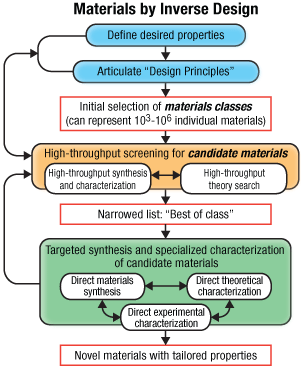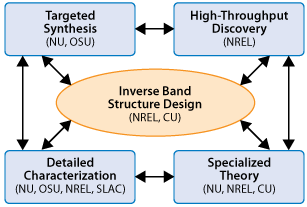Inverse Design Approach
This page describes the inverse materials design methodology used by the Center for Inverse Design, which integrates and combines the following: (1) theory, or prediction, (2) synthesis, or realization, and (3) characterization, or validation. The result of this approach is an acceleration—by orders of magnitude—in developing new materials for solar energy technologies. The figure illustrates the research approach, outlined under the three primary steps.

Illustration showing the flow of the three-part research approach used by the Center for Inverse Design
Step 1: Design Principles
- Articulate target properties for a given desired functionality.
- Employ and further develop a set of overarching "design principles." These physical mechanisms have been identified in previous theoretical research efforts.
Step 2: High-Throughput Screening
- Based on the design principles, choose initial "classes of materials," which each represent 103 to 106 individual compounds.
- Use theoretical inverse band structure (IBS) methods, in parallel with experimental high-throughput synthesis and characterization (HTSC) methods, to narrow these classes to a list of promising individual candidate ("best of class") compounds. For example:
- IBS identifies the optimal compositions (x,y) and/or atomic arrangements that maximize the hole concentration while maintaining optical transparency.
- HTSC provides validation and complementary information by synthesizing 103 to 104 samples per class using either composition-spread physical vapor deposition or combinatorial hydrothermal synthesis approaches.
- Measure the target materials properties of interest using high-throughput mapping tools specifically developed for this purpose.
- Finally, use advanced techniques and tools of data analysis and data mining to compare with the IBS results and to identify the "best-of-class" materials rationally.
Step 3: Targeted Synthesis and Characterization
- Use targeted synthesis, specialized theory, and direct characterization to investigate individual candidates in greater detail. For example, explore the materials synthesis routes, defect structures and models, and fine-tuning of the target properties.
- Feed back the results of these scrutinized investigations into a second optimization loop, if needed.
Interdependencies Among the Center's Components
The Center has five activity components: (1) Inverse Band Structure Design, (2) Targeted Synthesis, (3) High-Throughput Discovery, (4) Detailed Characterization, and (5) Specialized Theory. The following descriptions and schematic highlight the interdependencies among these components.
At the beginning of a materials design project, we establish the main physical problems critical to achieving the target properties for the desired functionality. Thus, initial Targeted Synthesis (NU, OSU) and Detailed Characterization (NU, OSU, NREL, SLAC), as well as Specialized Theory (NU, NREL, CU) provide input to set up: (1) an appropriate IBS Design (NREL, CU) as the central element and driver of the materials-by-design approach, and (2) the High-Throughput Discovery (synthesis and characterization; NREL).
These initial studies are especially relevant, because the IBS and high-throughput methodologies are most effective when only those physical properties are included in the optimization that are critical to achieving the desired functionality.
During the IBS Design, the theory results are cross-validated with and complemented by the High-Throughput Discovery. After an IBS iteration, when first predictions of candidate materials systems are available, Targeted Synthesis and Detailed Characterization of these candidates are used to validate the theoretical predictions, and to identify possible additional physical properties that may be relevant to focus the IBS Design and High-Throughput Discovery in a second optimization step, if needed.
In the last stage of a materials design project, the ultimate selections of specific materials proposed by IBS Design and High-Throughput Discovery are subject to a targeted, scrutinized Detailed Characterization and Targeted Synthesis. This work validates the predicted and designed properties and determines additional basic materials properties that may be of interest to the materials science community.

Schematic illustrating the interdependencies among the five main components within the Center for Inverse Design. Key to partners: NREL=National Renewable Energy Laboratory, OSU=Oregon State University, NU=Northwestern University, SLAC=Stanford Linear Accelerator Center, CU=University of Colorado at Boulder.
